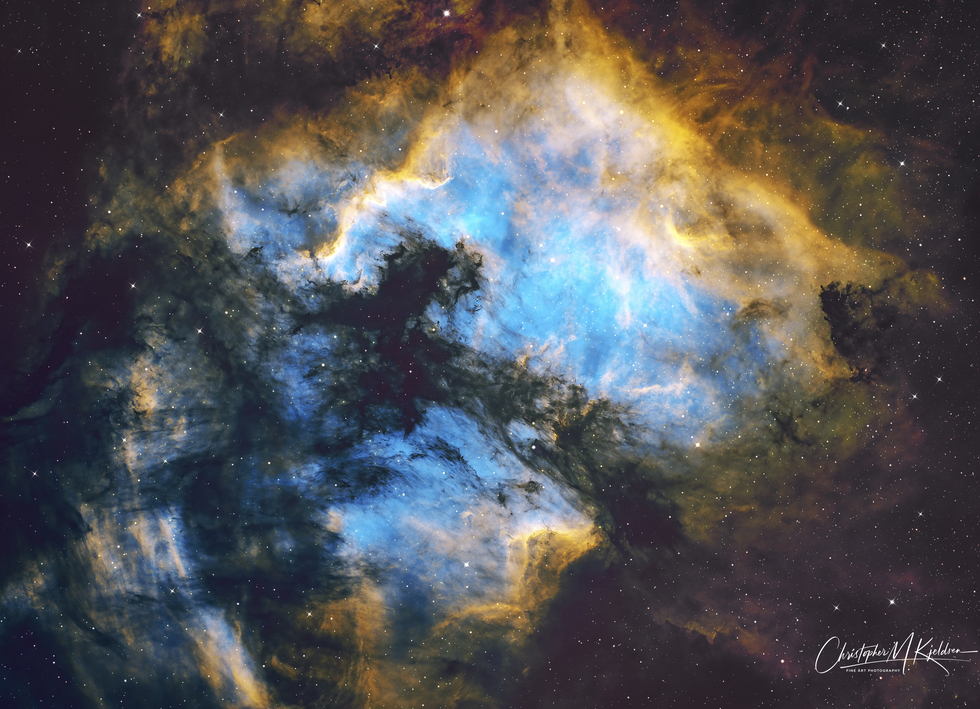NGC 7000 The North America Nebula
NGC 7000 The North America Nebula
The North America Nebula (NGC 7000 or Caldwell 20) is an emission nebula in the constellation Cygnus, close to Deneb (the tail of the swan and its brightest star). It is named because its shape resembles North America.
On October 24, 1786, William Herschel, observing from Slough, England, noted a “faint milky nebulosity scattered over this space, in some places pretty bright.” The most prominent region was cataloged by his son John Herschel on August 21, 1829. It was listed in the New General Catalogue as NGC 7000, where it is described as a "faint, most extremely large, diffuse nebulosity.”
In 1890, the pioneering German Astro photographer Max Wolf noticed this nebula's characteristic shape on a long-exposure photograph and dubbed it the North America Nebula.
The North American Nebula covers a region more than ten times the area of the full moon, but its surface brightness is low, so normally, it cannot be seen with the unaided eye. Binoculars and telescopes with large fields of view (approximately 3°) will show it as a foggy patch of light under sufficiently dark skies. However, using a UHC filter, which filters out some unwanted wavelengths of light, it can be seen without magnification under dark skies. Its shape and reddish color (from the hydrogen Hα emission line) show up only in photographs of the area.
The portion of the nebula resembling Mexico and Central America is known as the Cygnus Wall. This region exhibits the most concentrated star formation.
The distances to the North America and Pelican nebulae were controversial because there are few precise methods for determining how far away an HII region lies. Until 2020, most astronomers accepted a value of 2,000 light years, though estimates ranged from 1,500 to 3,000 light years. But in 2020, the Gaia astrometry spacecraft measured the distances to 395 stars lying within the HII region, giving the North America and Pelican nebulae a distance of 2,590 light-years (795±25 parsecs). The entire HII region Sh2-117 is estimated to be 140 light-years across, and the North American nebula stretches 90 light-years north to south.
On October 24, 1786, William Herschel, observing from Slough, England, noted a “faint milky nebulosity scattered over this space, in some places pretty bright.” The most prominent region was cataloged by his son John Herschel on August 21, 1829. It was listed in the New General Catalogue as NGC 7000, where it is described as a "faint, most extremely large, diffuse nebulosity.”
In 1890, the pioneering German Astro photographer Max Wolf noticed this nebula's characteristic shape on a long-exposure photograph and dubbed it the North America Nebula.
The North American Nebula covers a region more than ten times the area of the full moon, but its surface brightness is low, so normally, it cannot be seen with the unaided eye. Binoculars and telescopes with large fields of view (approximately 3°) will show it as a foggy patch of light under sufficiently dark skies. However, using a UHC filter, which filters out some unwanted wavelengths of light, it can be seen without magnification under dark skies. Its shape and reddish color (from the hydrogen Hα emission line) show up only in photographs of the area.
The portion of the nebula resembling Mexico and Central America is known as the Cygnus Wall. This region exhibits the most concentrated star formation.
The distances to the North America and Pelican nebulae were controversial because there are few precise methods for determining how far away an HII region lies. Until 2020, most astronomers accepted a value of 2,000 light years, though estimates ranged from 1,500 to 3,000 light years. But in 2020, the Gaia astrometry spacecraft measured the distances to 395 stars lying within the HII region, giving the North America and Pelican nebulae a distance of 2,590 light-years (795±25 parsecs). The entire HII region Sh2-117 is estimated to be 140 light-years across, and the North American nebula stretches 90 light-years north to south.
SPECIFICATIONS
Telescope
Takahashi FSQ-106EDX4
Camera
QHY 600M Pro
Location
IC Astronomy Observatory, Spain
Date of observation
9/20/23
Filters
Astrodon: Halpha, SII, OIII
Processing
• PixInsight (Hubble Pallet) • Lightroom • Photoshop



